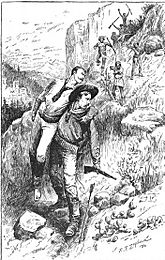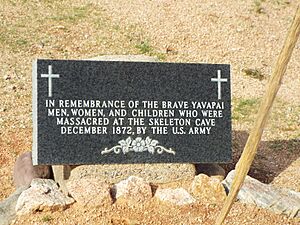Yavapai Wars facts for kids
Quick facts for kids Yavapai Wars |
|||||||
|---|---|---|---|---|---|---|---|
| Part of the Apache Wars | |||||||
 Skeleton Cave |
|||||||
|
|||||||
| Belligerents | |||||||
| Yavapai: Yavapai Allies: |
|||||||
| Commanders and leaders | |||||||
| Pauline Weaver George Crook Charles King |
Delshay Nanni-chaddi† |
||||||
| Casualties and losses | |||||||
| 741 to 1,075 killed directly, Yavapai population declined by 4,000 to over 5,500 overall from various causes | |||||||
The Yavapai Wars, also known as the Tonto Wars, were a series of conflicts. They took place between the Yavapai and Tonto Apache tribes and the United States. These wars happened in the Arizona Territory.
The fighting started around 1861. This was when American settlers began moving onto Yavapai and Tonto lands. At that time, the Yavapai were often seen as part of the Western Apache. This was because they had strong ties with tribes like the Tonto and Pinal. The wars ended when the Yavapai were forced to leave the Camp Verde Reservation. They were moved to San Carlos on February 27, 1875. This day is now called Exodus Day.
Contents
Why Did Conflict Start?
After the Mohave people lost much of their power, the Tolkepaya Yavapai knew they needed new friends. They wanted to stay safe. In April 1863, a well-known Tolkepaya leader named Quashackama met with Charles Poston. He was the superintendent of Indian affairs for the Arizona Territory.
They met at Fort Yuma with leaders from other tribes. These included the Pimas, Mohaves, Maricopas, and Chemehuevis. They signed an agreement to help trade safely between the tribes and the Americans. However, this was not an official treaty. This meant it was not legally binding.
More and more settlers kept arriving. Soon, they greatly outnumbered the Yavapai. These settlers wanted the government to remove the Yavapai from the land. They wanted to use the land for themselves. A local newspaper editor even wrote that "Extermination is our only hope."
Early Attacks and Retaliation
In early January 1864, the Yavapai raided ranches. These ranches supplied cattle to miners in the Prescott area. Because of these raids and other killings, a group of volunteers was formed. They wanted to stop future attacks.
King S. Woolsey led these well-armed volunteers. Their goal was to follow the raiding party back to their camp. What happened next is a sad part of Arizona history. It is known as the Bloody Tanks incident.
In December 1864, soldiers from Fort Whipple attacked two Yavapé camps. They killed 14 people and wounded seven. The next month, Fort Whipple soldiers attacked another Yavapé group. This time, 28 people were killed. This included their leader, Hoseckrua. Some of those killed worked for the US Indian agent in Prescott.
Life on Reservations
In 1864, Arizona Territory Governor John Goodwin suggested that all tribes be controlled. He wanted them sent to reservations. That same year, the US Army made a strong statement. They said all Apache Indians in the territory were hostile. They also said all Apache men old enough to fight would be killed if found. This would happen unless they surrendered as prisoners. The Yavapai were often grouped with the Apache.
Soon after, a Pai leader was murdered by Americans. In response, a group of Pai attacked some wagon trains. They closed the road between Prescott and Fort Mohave. The US Army then declared all Indians in most Yavapai territory to be "hostile." This meant they could be "exterminated."
On November 5, 1871, the Wickenburg stagecoach was attacked. This event is called the Wickenburg Massacre. A driver and five passengers were killed. This attack led to the Yavapai being moved from Prescott to the San Carlos Reservation. This happened in February 1875.
The Yavapai War (1871-1875)
| Yavapai War | |||||||
|---|---|---|---|---|---|---|---|
| Part of the Yavapai Wars, Apache Wars | |||||||
 The rescue of Lieutenant Charles King by Sergeant Bernard Taylor during the battle at Sunset Pass in 1874. |
|||||||
|
|||||||
| Belligerents | |||||||
| Yavapai Apache |
|||||||
| Commanders and leaders | |||||||
| George Crook Charles King |
Delshay Nanni-chaddi † |
||||||
The Yavapai War was a conflict in the United States from 1871 to 1875. It involved the Yavapai and Western Apache groups in Arizona. The war started after the Camp Grant massacre on April 28, 1871. In that event, nearly 150 Pinal and Aravaipa Apaches were killed. This was done by O'odham warriors, Mexican settlers, and American settlers.
Some survivors fled north into the Tonto Basin. They sought safety with their Yavapai and Tonto friends. After this, the United States Army began campaigns. General George Crook led these efforts. His goal was to force the native people back onto reservations. This conflict is different from the Chiricahua War. That war was mainly between Americans and Chiricahua warriors led by Cochise.
In December 1872, Colonel George Crook used Apache scouts. They helped him find a cave near the Salt River Canyon. The Guwevkabaya Yavapai were using this cave as a hiding place. From there, they launched attacks on White settlers.
On December 28, Captain William Brown led 120 of Crook's men. They were joined by 100 Pima scouts. They surrounded the cave in what became the Battle of Salt River Canyon. About 110 Kwevkepaya were trapped inside. Brown ordered his soldiers to fire at the cave's roof. This caused rocks and metal pieces to fall on the Guwevkabaya.
With nowhere to go, the trapped people gathered at the cave's entrance. Soldiers, including General Crook, pushed large rocks down on them. This killed 76 people. The survivors were taken to Camp Grant as prisoners. The Yavapai were very discouraged by this and other actions by Crook. They surrendered at Camp Verde on April 6, 1873. This event marked the beginning of the Tonto Basin Campaign.
In 1925, Yavapai from the Fort McDowell Reservation gathered bones from the cave. By then, it was called Skeleton Cave. They buried the bones in the Fort McDowell cemetery.
Exodus Day: A Forced March
In 1886, many Yavapai helped the US Army. They served as scouts against Geronimo and other Chiricahua Apache. The wars ended with the forced removal of the Yavapai and Tonto people. They were moved from the Camp Verde Reservation to San Carlos. This happened on February 27, 1875, and is now known as Exodus Day.
About 1,400 people were moved during this journey. The Yavapai received no wagons or rest stops. This difficult march led to 375 deaths.


